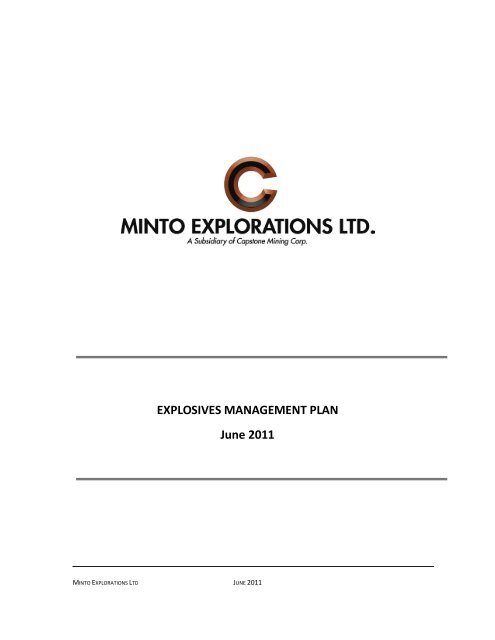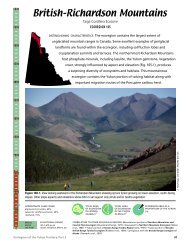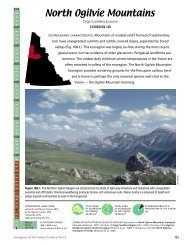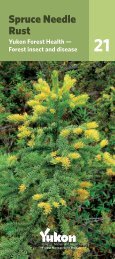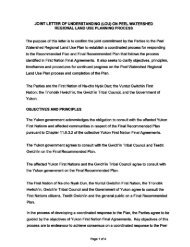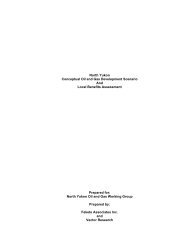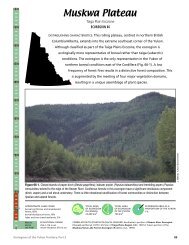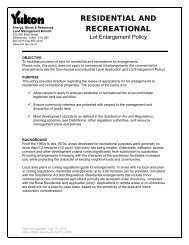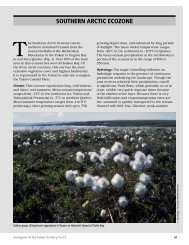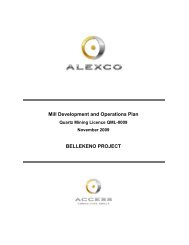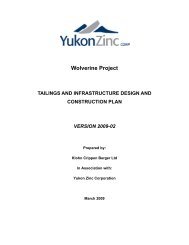EXPLOSIVES MANAGEMENT PLAN June 2011 - Energy, Mines ...
EXPLOSIVES MANAGEMENT PLAN June 2011 - Energy, Mines ...
EXPLOSIVES MANAGEMENT PLAN June 2011 - Energy, Mines ...
You also want an ePaper? Increase the reach of your titles
YUMPU automatically turns print PDFs into web optimized ePapers that Google loves.
<strong>EXPLOSIVES</strong> <strong>MANAGEMENT</strong> <strong>PLAN</strong><br />
<strong>June</strong> <strong>2011</strong><br />
MINTO EXPLORATIONS LTD JUNE <strong>2011</strong>
Table of Contents<br />
1.0 INTRODUCTION ................................................................................................... 1<br />
1.1 Explosives Management Plan Objectives………………………………………………………..………..……..1<br />
2.0 EXPLOSIVE USAGE ............................................................................................... 1<br />
2.1 Blasting Agent Types, Transportation and Storage………………………………………………….………1<br />
3.0 BEST <strong>MANAGEMENT</strong> PRACTICES ......................................................................... 2<br />
4.0 REVIEW AND IMPROVEMENTS ............................................................................ 3<br />
APPENDICIES<br />
Appendix A Minto Explorations Ltd. Drill and Blast Standards<br />
Appendix B Dyno Nobel Disposal Guidance<br />
Appendix C Dyno Nobel Environmental Considerations<br />
Appendix D Dyno Nobel Best Loading Practices (Fragmite, Fragmax)
MINTO EXPLORATIONS LTD.<br />
<strong>EXPLOSIVES</strong> <strong>MANAGEMENT</strong> <strong>PLAN</strong><br />
1.0 INTRODUCTION<br />
Minto Mine is a high-grade copper and gold mine that is located 240 km north of Whitehorse,<br />
Yukon. Operations began in October 2007 and are ongoing at this time.<br />
The mine is located in the boreal forest at an elevation of about 760 m ASL. The access road<br />
starts at the western side of the Yukon River crossing site, continuing north adjacent to the<br />
Yukon River and then heading southwest 12 km up the Minto Creek valley to the Minto mine<br />
site. Access to the mine over the Yukon River is gained by way of a barge in open-water months,<br />
an ice-road during winter months and by air during the shoulder seasons.<br />
As with most mines, Minto Mine employs explosives as the primary means of breaking rock.<br />
1.1 Explosives Management Plan Objectives<br />
The purpose of the Explosive Management Plan is to outline management practices employed at<br />
Minto Mine that are aimed at minimizing the safety and environmental risks of handling<br />
nitrates, which are present in blasting agents. Specifically, methods used to minimize nitrate<br />
losses to the environment will be explained.<br />
2.0 EXPLOSIVE USAGE<br />
Minto Explorations Ltd. (MintoEx) contracts Dyno Nobel to supply explosives to the Minto Mine<br />
site. Dyno Nobel is a leading supplier of industrial explosives to the mining industry and employs<br />
a health, safety and environment management system known as Zero Harm. It captures all<br />
aspects of occupational health and environmental releases. Blasting services are provided by<br />
Pelly Construction Ltd., a Yukon-based mining contractor with a long history of development in<br />
the north. Pelly Construction Ltd. counts safety and environment among their key core values<br />
and it is with their combined expertise and guidance that MintoEx has carried out over 1000<br />
successful blasts at the mine to date.<br />
2.1 Blasting agent types, transportation, and storage<br />
Minto Mine uses the following blasting agents:<br />
- ANFO (94% Ammonium Nitrate, 6% fuel oil) which contains over 30% by weight<br />
nitrogen. Ammonium nitrate takes the form of porous prills (small spherical pellets<br />
about 1mm in diameter), which absorb fuel oil to form an explosive. The nitrogen<br />
present is readily soluble.<br />
MINTO EXPLORATIONS LTD JUNE <strong>2011</strong> 1
MINTO EXPLORATIONS LTD.<br />
<strong>EXPLOSIVES</strong> <strong>MANAGEMENT</strong> <strong>PLAN</strong><br />
- Site mixed emulsion, which uses the same ammonium nitrate / fuel oil chemistry as<br />
ANFO, but differs in the physical form the reactants take: the final product is<br />
substantially denser than ANFO and highly water-resistant.<br />
This product is a mixture of emulsion (typically 70%) and ammonium nitrate prill<br />
(typically 30%). The prill is identical to the sort described previously. The emulsion<br />
component is a thick gel-like mixture in which the reactants are intimately blended at<br />
the molecular level, together with emulsifiers that stabilize it and render it waterresistant.<br />
Emulsion and ANFO contain similar amounts of nitrogen by weight, but emulsion is<br />
much less soluble. The prill, while not water resistant on its own, is completely<br />
encapsulated in the emulsion component, and is thus inaccessible to water.<br />
- Dynosplit C is a small-diameter, water resistant, packaged watergel explosive. It is used<br />
in pre-shear blasting and makes up substantially less than 1% of Minto’s explosive usage<br />
by weight.<br />
On a typical production pattern, approximately 70% of the holes will be loaded with ANFO and<br />
30% with site-mixed emulsion, depending on the number of holes containing water.<br />
Blasting agents are stored on site at a controlled area managed by Dyno Nobel in accordance<br />
with a permit and related guidance provided by Natural Resources Canada, Explosives Safety<br />
and Security Branch.<br />
The blasting agents are transported to the drill pattern by Dyno Nobel employees. Dyno Nobel is<br />
responsible for product sourcing, storage, quality control, and delivery to the blasthole. The<br />
Pelly blaster directs the loading of the product and is ultimately responsible for loading and<br />
firing each blast.<br />
3.0 BEST <strong>MANAGEMENT</strong> PRACTICES<br />
MintoEx works closely with both Dyno Nobel and Pelly Construction Ltd. to ensure that blasting<br />
activities are conducted with minimal environmental and health/safety risk.<br />
Since both safety and environmental risks are related (risks are increased from deficient<br />
handling practices), standard operating procedures (SOPs) have been developed which address<br />
both issues jointly.<br />
The first means of addressing explosive reagent safety and best practices related to<br />
environmental management is awareness. Blast crews and engineering staff are aware that<br />
nitrates and ammonia are generally the compounds of greatest concern for water quality<br />
MINTO EXPLORATIONS LTD JUNE <strong>2011</strong> 2
MINTO EXPLORATIONS LTD.<br />
<strong>EXPLOSIVES</strong> <strong>MANAGEMENT</strong> <strong>PLAN</strong><br />
degradation. Nitrates can be directly toxic to aquatic life or they can indirectly affect aquatic life<br />
through decreasing dissolved oxygen levels in water or causing eutrophication. Ammonia<br />
toxicity is related to pH and temperature of the water.<br />
The means by which blasting agents can escape into the environment must be identified and<br />
known by personnel. There are two mechanisms by which blasting agents can contaminate<br />
water around the mine: spillage during loading, and leaching of the blasting agents in wet blast<br />
holes.<br />
The first of these is addressed by emphasizing to blast crews the importance of minimizing<br />
spillage and dealing properly with any that may occur. The second is addressed by requiring that<br />
holes loaded with water soluble products be lined if there is any possibility of wet ground in the<br />
area.<br />
In addition, the following design and loading practices are in place to minimize ammonia /<br />
nitrate losses to the environment:<br />
- Design considerations: blasts are designed to maximize efficiency of blasting agents.<br />
- Blast hole liners: liners are used even when minimal amounts of water are present. If<br />
there is excessive water, blasters will use emulsion instead.<br />
- Minimize sleep time: holes are not loaded with blasting agents until necessary in order<br />
to reduce the time elapsed between loading and detonation.<br />
- Waste disposal: Disposal of blasting reagent packaging and related waste is done so in<br />
accordance with the BSSM Disposal Guidance document (see Appendix B).<br />
These practices are documented in the mine’s SOPs; these are attached for reference.<br />
4.0 REVIEW AND IMPROVEMENTS<br />
MintoEx will use the guidance outlined in this plan to minimize the impacts of using ammonium<br />
nitrate-based blasting agents. Practices used at site will be reviewed in conjunction with<br />
industry best practices and observed water quality. Improvements can and will be made as<br />
required. Currently MintoEx is designing a trial experiment wherein the site-mixed emulsion<br />
formulation will be changed from a 70/30 emulsion/prill ratio to one with a greater emulsion<br />
content: this will be evaluated in order to gauge improvements to blasting efficiency and water<br />
quality. If this practice is adopted, this plan will be modified and submitted to EMR accordingly.<br />
MINTO EXPLORATIONS LTD JUNE <strong>2011</strong> 3
APPENDIX A<br />
Minto Explorations Ltd. Drill and Blast Standards
Drilling and Blasting Standards<br />
<strong>June</strong> <strong>2011</strong><br />
1
Table of Contents<br />
1. Drills, Drill Bits, and Hole Sizes ..................................................................................................................................... 3<br />
2. Pattern Design and Loading ......................................................................................................................................... 3<br />
Standard Grid Spacing – 12.0m Waste Benches.................................................................................................................. 3<br />
Wall and Buffer Rows – 12.0m Waste Benches ................................................................................................................... 3<br />
Pre-Shear Drilling ............................................................................................................................................................ 5<br />
Hole Numbering .............................................................................................................................................................. 5<br />
Cutoff Design .................................................................................................................................................................. 6<br />
Gaps .............................................................................................................................................................................. 6<br />
3. Explosives .................................................................................................................................................................. 7<br />
ANFO ............................................................................................................................................................................. 7<br />
Wet Product .................................................................................................................................................................... 7<br />
De-Watering vs. Wet Product Use: Costs ........................................................................................................................... 7<br />
Product Density and Collar Adjustments in Wet Holes ......................................................................................................... 7<br />
Mini-prill vs. Heavy ANFO ................................................................................................................................................. 7<br />
Blasting Accessories ......................................................................................................................................................... 8<br />
Tie-in and Shot Direction .................................................................................................................................................. 8<br />
Double Priming ............................................................................................................................................................... 9<br />
Stemming the Collar ........................................................................................................................................................ 9<br />
4. Firing of Blasts ........................................................................................................................................................... 9<br />
Clearance Maps ............................................................................................................................................................... 9<br />
Mill Area Involvement ...................................................................................................................................................... 9<br />
2
1. Drills, Drill Bits, and Hole Sizes<br />
Pelly currently supplies the mine with drilling services using four drills, two of which are set up to drill 6 ¾” holes and two of<br />
which drill 9 7/8” holes. The former are used in 6.0m ore benches and the latter in 12.0m waste benches.<br />
Generally speaking, the amount of stemming required in a hole is proportional only to its diameter: if less than 20x the hole<br />
diameter is used in stemming, a large portion of the explosive energy will be lost through the collar. Air blast, fly rock, and poor<br />
fragmentation will result.<br />
A 9 7/8” hole (0.251m) should thus have, at a minimum, 5.0m of stemming. Given this, it is impractical to use such a large hole in<br />
a short bench; thus, 6.0m benches require smaller holes.<br />
2. Pattern Design and Loading<br />
Patterns are generally designed one bench at a time in Vulcan, then cut into<br />
individual blasts based on the immediate needs of the mine.<br />
Drill patterns should always be equilateral: all holes are equidistant from one<br />
another, and burden is related to spacing by a factor of 0.866 (√0.75).<br />
Equilateral patterns provide better energy distribution and thus better<br />
fragmentation than square or rectangular designs. Another advantage is that<br />
burden and spacing are maintained regardless of shot direction, as illustrated in<br />
the diagram to the right, freeing operations to cut off and shoot patterns in a<br />
wide variety of convenient shapes.<br />
One disadvantage to equilateral patterns is that the driving width available to<br />
powder trucks and other vehicles on the pattern is equal to the burden, rather<br />
than the spacing. This may be a factor in tightly spaced ore blasts on 6m<br />
benches.<br />
Standard Grid Spacing – 12.0m Waste Benches<br />
The main way in which powder factor is varied is to adjust the grid spacing; ideally, it is adjusted to maintain consistent<br />
fragmentation as rock characteristics change in the pit. This is essentially a reactive process: where hard digging is encountered<br />
that cannot be explained by loading, design, or product problems, the grid should be tightened to increase powder factor.<br />
Grid spacing can be increased, and powder factor thereby decreased, if fragmentation is consistently better than that required for<br />
efficient excavator operation.<br />
The table below lists standard grid spacings for different pattern types. Also listed are theoretical powder factors for each grid<br />
spacing, in kg/BCM, for a hole loaded with Fragmax ANFO.<br />
Waste Blasts – 12m benches, 9 7/8” hole diameter<br />
7.0m eq (6.06 burden) 1.0m subgrade 5.0m collar 0.82 kg/BCM<br />
Overburden Blasts – 12m benches, 9 7/8” hole diameter<br />
7.0m eq (6.06 burden) 1.0m subgrade 5.0m collar 0.82 kg/BCM<br />
Overburden blasts were drilled to the same specifications as waste blasts. If, in the future, large quantities of overburden are to<br />
be mined, an effort should be made to find a grid spacing that minimizes powder factor while maintaining acceptable digging.<br />
Wall and Buffer Rows – 12.0m Waste Benches<br />
The row closest to the wall, besides the pre-shear, is termed the wall row. It is drilled with the 6 3/4" diameter bit, with no<br />
subgrade, and is loaded with 5.0m of powder and a reduced stemming load. The spacing between holes is 4.0m, as is the burden<br />
to the next row.<br />
The next row is termed the buffer row, and is drilled with the 9 7/8” bit, no subgrade if there is to be a catch bench and regular<br />
subgrade if there is not, and loaded slightly lighter than regular specifications (5.5m collar instead of 5.0, full stemming).<br />
Following this, spaced 6.0m away, the equilateral pattern melds into the buffer row, adjusted to maintain a well-balanced grid.<br />
3
7.0m Equilateral Grid<br />
Note: increase stemming by 0.5m if<br />
loading with Fragmite instead of ANFO.<br />
Wall row is offset 1.0m from toe.<br />
The following table lists hole parameters and the resulting powder factors for each hole type:<br />
4
Production Holes Buffer Row Wall Row<br />
Hole dia 0.25 Hole dia 0.25 Hole dia 0.17<br />
Stemming 5.00 Stemming 5.50 Stemming 7.00<br />
Subgrade 1.00 Subgrade 0.00 Subgrade 0.00<br />
H 12.00 H 12.00 H 12.00<br />
Charge Length 8.00 Charge Length 6.50 Charge Length 5.00<br />
Expl Density 1050 Expl Density 1050 Expl Density 1050<br />
Powder Charge (kg) 416 Powder Charge (kg) 338 Powder Charge (kg) 121<br />
Burden 6.06 Burden 6.00 Burden 4.00<br />
Spacing 7.00 Spacing 7.00 Spacing 4.00<br />
Vol/hole 509 Vol/hole 504 Vol/hole 192<br />
Resulting B/S ratio 0.87 Resulting B/S ratio 0.86 Resulting B/S ratio 1.00<br />
Resulting PF (kg/BCM) 0.82 Resulting PF (kg/BCM) 0.67 Resulting PF (kg/BCM) 0.63<br />
Pre-Shear Drilling<br />
Pre-shear is a technique in which closely-spaced small diameter holes, drilled to follow the final contour of the wall, are loaded<br />
with a decoupled charge. All holes are fired simultaneously, encouraging the formation of a fracture plane between them. Much of<br />
the strain energy from production / buffer blastholes, upon meeting this discontinuity, will be reflected back, instead of continuing<br />
into the wall where it would result in backbreak.<br />
The decoupled charge – that is, one in which the charge diameter is substantially smaller than the hole diameter – is meant to<br />
reduce the magnitude of the peak strain around the blasthole, preventing damage to the wall in its immediate vicinity.<br />
Pre-shear drilling significantly improved the quality of highwalls at Minto after its introduction in the main (Area 1) pit.<br />
When laying out holes, no offset from the toe is needed. The holes are angled to follow the wall contour: the drill has the ability<br />
to point the mast away from the machine and thereby drill the hole underneath itself. Standard spacing is 2.0m. Pre-shear holes<br />
are always done for an entire 12.0m high section of wall, even if the bench contains ore and will actually be mined in 6.0m cuts.<br />
The holes are loaded with Dynosplit C, which is a packaged watergel (similar to an emulsion). The 1.5” / 40mm diameter size is<br />
used at Minto. Tie-in is done using detonating cord: all holes in a pre-shear blast fire simultaneously.<br />
Hole Numbering<br />
Production Holes<br />
Hole numbers should be thought of as a concatenation of a row and a column<br />
number. Numbering on an equilateral pattern should look like the image shown to<br />
the right. The first two digits will represent the row number, while the last two will<br />
represent the column number.<br />
This will allow a blaster to navigate a pattern with less time spent referencing a<br />
map. Blasters will also be better able to infer hole numbers when stakes are lost<br />
or unreadable.<br />
The screenshot below demonstrates how Vulcan can be configured to generate<br />
this style of numbering:<br />
5
A note: when deleting holes, you will be asked if you would like Vulcan to check remaining hole names or leave them<br />
undisturbed. You may select either option: if using row-by-row naming, Vulcan will not ruin the grid if a hole is deleted.<br />
Buffer and Wall Rows<br />
Hole numbering should typically start at 100. Wall holes receive a “W” prefix while buffer holes should have a “B” prepended to<br />
their names.<br />
Cutoff Design<br />
Larger blasts are more productive in the sense that less time is spent evacuating the pit, setting up guards, etc. Cutoff size should<br />
take into consideration blasted muck inventories in the pit, the input of the blaster, hole conditions (caving / redrills), and the<br />
need to make cutoffs of appropriate shape.<br />
Gaps<br />
The row name comes first. This<br />
should be started at 5, so that<br />
numbers below this are reserved<br />
for buffer rows and trim.<br />
The “hole number” here refers to<br />
the last two digits of what will<br />
eventually be the hole name;<br />
essentially, the ‘column’<br />
descriptor.<br />
Enabling this check box is<br />
necessary to ensure that rows line<br />
up properly.<br />
This will avoid confusing hole<br />
names like ‘51’, replacing them<br />
instead with ‘501.’<br />
When a pattern is drilled next to another that has not yet been shot, a three-row gap must be left adjacent to the drilled-butunshot<br />
pattern. Holes drilled closer to the unshot pattern would cave or bridge due to vibration from blasting.<br />
6
3. Explosives<br />
ANFO<br />
ANFO is a mixture of ammonium nitrate prill (94%) and fuel oil (6%). AN is fully water soluble and therefore this product is only<br />
usable in completely dry holes, or in holes that can be pumped dry and then lined.<br />
The ANFO used at Minto is a mini-prill product called Fragmax with a higher bulk density than typical ANFO: 1050 kg/m 3 vs. more<br />
common values of 840kg/m 3 .<br />
As of <strong>June</strong> <strong>2011</strong>, Fragmax costs ~$0.82/kg.<br />
Wet Product<br />
The product used at Minto is a pumpable emulsion / prill blend in a 70/30 ratio, sold under the name Fragmite. The emulsion is<br />
pre-sensitized using micro-balloons rather than gassed in the truck, as is more common, and the prill component uses Fragmax<br />
mini-prill.<br />
The use of a pre-sensitized emulsion makes loading easier (gassed products must be left to stand for ~20 minutes before<br />
stemming the hole) and eliminates the need to stock and mix separate gassing compounds.<br />
Fragmite is fully water resistant and is loaded directly into unlined wet blastholes. Care must be taken when loading to ensure<br />
that water is not entrained in the product column; thus, standard practice is to lower the hose to the bottom of the hole and<br />
retract it at the same rate at which the hole fills. This keeps the hose in the product all the way up, pushing water out of the hole.<br />
As of <strong>June</strong> <strong>2011</strong>, 70/30 Fragmite costs ~1.50/kg.<br />
Fragmite is available in mixtures from 60% to 100% emulsion; it is mixed in the truck and the ratio can be varied.<br />
De-Watering vs. Wet Product Use: Costs<br />
Blasters can either attempt to pump / bag a hole or simply load it with wet product; this is left to their discretion.<br />
Due to the higher density of Fragmite vs. Fragmax (ANFO), upgrading a hole to emulsion loads an additional 99kg of explosive<br />
into the hole. The product is also 83% more expensive on a per-kg basis. At the aforementioned costs, a dry hole costs $341<br />
while a wet hole costs $772: wet loading is more expensive by a factor of 2.25.<br />
Clearly, the combination of dry product and a liner is significantly cheaper than changing the product type to wet; where possible,<br />
pumping and bagging should be encouraged. Generally, holes that have standing water (as opposed to an inflow of water) can be<br />
pumped.<br />
Product Density and Collar Adjustments in Wet Holes<br />
The bulk density of Fragmite is approximately 1300 kg/m 3 . Its use thus results in higher powder factors than an equivalent<br />
volume of ANFO. This suggests that patterns could be expanded or collars dropped when using wet products.<br />
Indeed, the collars could be dropped substantially if one sought to keep powder factors equivalent between wet and dry holes:<br />
from 5.0m in an ANFO-loaded hole to 6.5m in a Fragmite-loaded hole. This would likely give poor results, however.<br />
One consideration is that emulsion-heavy products tend to release more of their energy as shock, rather than gas, making them<br />
better suited to fracturing hard rock, but resulting in less heave of the muck pile. Given equal powder factors, this makes for<br />
tighter digging, and is one of the reasons why emulsion cannot always be substituted for ANFO on a per-kg basis.<br />
That said, a small adjustment to the collars should be tried, and the effects evaluated: collars should be reduced by 0.5m in wet<br />
holes.<br />
Mini-prill vs. Heavy ANFO<br />
Many mines achieve similar powder factors in dry and wet holes by using heavy ANFO products in dry holes (30% emulsion /<br />
70% prill, not water resistant, augured instead of pumped, 1240 kg/m 3 bulk density). Minto instead uses mini-prill due to<br />
emulsion storage constraints as well as the substantially higher cost of emulsion.<br />
7
Blasting Accessories<br />
Tie-ins at Minto are done using dual-delay detonators sold under the name EZ Det. These contain a 500ms delay element in the<br />
hole, like a standard downline, but have at their other end a shorter surface delay element.<br />
The figure below illustrates how these are connected within a row of blast holes. The first hole, on the left, would be initiated by a<br />
lead-in line (shown in yellow). The orange shock tube would propagate the ‘signal’ to the green delay element (500ms) and the<br />
blue delay element (42ms). The next shock tube would thus be initiated 42ms later, and it has its own 500ms delay element, so<br />
its charge would detonate at 542ms.<br />
The long in-hole delay element ensures that the much shorter surface delays have time to fire before the ground starts moving:<br />
by the time 500ms delays have finished and the powder column is initiated, the surface delay elements are burning several rows<br />
further back. This prevents cut-offs, which are incidents in which ground movement tears apart the network of tie-ins before it<br />
has had a chance to initiate all of the holes in the pattern.<br />
Connections between rows are done using EZTL-brand trunk-line connectors: these consist of a short delay element on one end<br />
and a J-hook connector on the other.<br />
EZ-Dets are available with 17, 25, and 42ms surface delays; we currently stock only the 25ms units. EZ-TLs are available in 9, 17,<br />
25, 33, 42, 67, 100, and 109 ms delays; we stock all but the 9 and the 67ms units.<br />
Tie-in and Shot Direction<br />
EZ Det Dual-Delay Connector<br />
(Downline with integrated surface delay)<br />
500ms 542ms 584ms 626ms<br />
Charge firing times, after blast initiation<br />
Tie-ins are generally not designed by engineering, but rather by the blast crew.<br />
The first row in a waste blast is always fired next to blasted muck or a free face. The latter is preferable: when material is free to<br />
move, fragmentation will generally benefit and a looser and more easily diggable muck pile will result. Such a muck pile is ideal<br />
for smaller excavators and especially loaders.<br />
All subsequent rows shoot “in to” that first row.<br />
42ms delay<br />
500ms delay<br />
Ore blasts, on the other hand, are shot as sinking cuts. A sinking cut is usually used to describe the first blast into a new bench,<br />
in which there is no free face to use for relief. Instead, a row in the middle is shot first, and subsequent rows use the void created<br />
there for relief. Sinking cuts tend to require higher powder factors and they may result in tighter digging.<br />
The direction of movement is toward the center of the blast rather than toward a free face: as a result, overall material<br />
displacement is smaller. This tendency to pile material up in the middle of the blast is useful for ore control: ore is not thrown<br />
across the bench.<br />
Since current ore control practice is to lay out post-blast ore boundaries based on pre-blast blasthole assays, minimizing material<br />
movement is important to the successful separation of ore from waste. Many mines accomplish this by choke blasting; that is,<br />
blasting into a semi-free face of blasted muck rather than into a proper free face. The small dimensions of Minto’s ore benches<br />
make this strategy impractical; there is generally not sufficient blasted inventory.<br />
8
Double Priming<br />
Double priming is done at the blasters’ discretion, usually on holes where broken ground or rehandle near the collar increases the<br />
chances of a large rock falling down the hole during stemming and cutting the downline.<br />
Cap scatter on a 500ms down-hole delay is sufficiently large that the powder column will almost always fully burn before the<br />
second primer would initiate. Therefore only one of the primers will be used, and if one is placed near the top of the charge, half<br />
of the double-primed holes, on average, will burn from top to bottom. This is unfavorable from an energy distribution /<br />
propagation perspective; therefore, top-priming should be avoided and both primers should be placed near the bottom of the<br />
hole.<br />
Stemming the Collar<br />
Drill cuttings should not be used to stem a hole. This is particularly important at Minto, as Pelly’s hammer drills make fine cuttings<br />
pile that will not properly confine a charge. Stemming wet holes with cuttings would result in a muddy mixture at the top of the<br />
hole; this provides no useful confinement.<br />
The ideal stemming material is crushed stone, 2-4cm in diameter. Stemming contributes only a very small volume to a blast –<br />
approximately one tenth of a percent – and therefore concerns over dilution are unwarranted. Ore need not be used as stemming<br />
material.<br />
4. Firing of Blasts<br />
This section is not meant to be a comprehensive set of instructions for the safe firing a blast: that information is documented<br />
formally in the SOP for blast clearance.<br />
Clearance Maps<br />
The area to be cleared is a 500m radius around the blast.<br />
When the cutoff for a blast is determined, the survey department will prepare a map showing the blast polygon, a circle outlining<br />
a 500m radius around it, a boundary showing the mill clearance zone, the mine’s road network, and numbered guard positions at<br />
each intersection of a road and the clearance circle.<br />
This map is provided to the Pelly foreman or clerk, who will distribute it widely on the day of the blast.<br />
Mill Area Involvement<br />
Past procedure at Minto was clear the mill building and surrounding areas: personnel retreated to safe locations underneath<br />
double roofs during any blast, and movement around mill buildings was restricted.<br />
As of May <strong>2011</strong>, this procedure is required only for blasts in which the mill area falls into the clearance zone. The blast map will<br />
clearly indicate when this is the case.<br />
9
APPENDIX B<br />
Dyno Nobel Disposal Guidance
DYNO NOBEL NORTH AMERICA<br />
BLAST SITE SAFETY MANUAL<br />
Explosives And Packaging Disposal<br />
1.0 APPLICATION<br />
This part of the Blast Site Policy applies to all wholly-owned DYNO NOBEL INC.<br />
operations and all joint ventures in which DYNO NOBEL INC. is a party.<br />
THE INFORMATION, PREVENTION MEASURES AND PRECAUTIONS SET FORTH HEREIN ARE<br />
TO BE USED AS GENERAL GUIDELINES ONLY AND DO NOT CONSTITUTE MINIMUM<br />
COMPLIANCE STANDARDS. FURTHER, THESE GUIDELINES ARE NOT INTENDED TO PROVIDE<br />
ANY BASIS BY WHICH ANY LEGAL OBLIGATION, DUTY OR LIABILITY MAY ARISE OR BE<br />
IMPOSED.<br />
2.0 INTRODUCTION<br />
The proper disposal of wastes that are sometimes generated at a blast site is a federal and<br />
state requirement. When explosive waste and packaging waste are involved, particular<br />
care must be exercised to maintain compliance with applicable regulations. The following<br />
sections will provide guidance for the proper management of both hazardous and nonhazardous<br />
explosive and packaging wastes.<br />
3.0 PURPOSE<br />
The purpose of this document is to provide specific guidelines for proper management of<br />
the following:<br />
Non-hazardous Explosive Related Waste<br />
Non-hazardous Packaging Waste<br />
Hazardous Explosive Waste<br />
Hazardous Packaging Waste<br />
4.0 Non-Hazardous Explosives Related Waste<br />
Appropriate efforts should be made to use raw materials and manufactured products for<br />
their intended use. If it has been determined that material and/or products must be<br />
disposed of, and the material/product cannot be classified as a hazardous waste,<br />
arrangements must be made with properly authorized disposal facilities. A material that is<br />
either corrosive, ignitable (including oxidizers), reactive, or toxic is not non-hazardous. If<br />
there is any uncertainty as to the proper classification of the material/product, contact the<br />
Corporate Environmental Manager or a qualified environmental consultant.<br />
The types of non-hazardous explosive related waste typically found on a blast site include:<br />
scrap Nonel tubing, scrap copper wire, and blasting agents or precursors heavily<br />
contaminated with soil. The blasting agents or precursors can only be classified as nonhazardous<br />
if they cannot detonate due to the amount of contamination; otherwise they<br />
should be placed into the bore hole and utilized for their manufactured/intended use.<br />
Section 18 Page 1 <strong>June</strong> 29, <strong>2011</strong>
DYNO NOBEL NORTH AMERICA<br />
BLAST SITE SAFETY MANUAL<br />
Municipal or industrial landfills are typically used to disposal of non-hazardous explosive<br />
related waste. Never use a landfill unless they are permitted by either the state<br />
environmental authority or the Environmental Protection Agency. Federal law attaches<br />
liability for disposed waste to the generator of the waste. It is recommended that an<br />
industrial landfill be used because of the higher degree of protection against liability issues.<br />
Landfill operators must know the types and quantities of waste they are receiving from<br />
generators to confirm they are in compliance with their permits. Arrange with the landfill<br />
operator for the disposal of non-hazardous explosive related waste in advance of<br />
transporting the waste to the landfill. If any questions arise over the documentation that<br />
the landfill operator is requesting, contact the Corporate Environmental Manager or a<br />
qualified environmental consultant.<br />
5.0 Non-Hazardous Packaging Waste<br />
Figure 1 provides a flow diagram to assist in the process of determining if the container<br />
can be managed as a hazardous or non-hazardous waste.<br />
Before disposing of non-hazardous containers, boxes should be broken-down and bags<br />
should be cut open to provide for the highest degree of product removal, and to address<br />
any potential confusion over management of the former container as a DOT packaging.<br />
To facilitate product removal to the highest degree, tap the outside of the bag with a stick.<br />
All material removed from the packaging is to be recovered and used for is manufactured<br />
use. It is required that the shipping name, identification number, and hazard warning labels<br />
on the debris be removed or obliterated. The removal or obliteration of these items serve<br />
to: address the concerns of a landfill operator or recycler; avoid undue concern of<br />
emergency responders at the scene of an incident; avoid intentional misuse of these items<br />
by criminals; and so forth. The non-hazardous debris would not be considered a DOT<br />
hazardous material and recycling of the packaging can be performed, or disposal at the<br />
type of landfills identified in Section 4.0 should be secured.<br />
6.0 Hazardous Explosives Waste<br />
Appropriate efforts should be made to use raw materials and manufactured products for<br />
their intended use. If it has been determined that material and/or products must be<br />
disposed of, and the material/product demonstrates it is corrosive, ignitable (including<br />
oxidizers), reactive, and/or toxic it is classified as a hazardous waste. If there is any<br />
uncertainty as to the proper classification of the material/product, contact the Corporate<br />
Environmental Manager or a qualified environmental consultant.<br />
The types of hazardous explosive related waste typically found on a blast site include:<br />
Reactive - Class 1 explosives, if discarded are hazardous waste because of their reactivity.<br />
They are given an EPA waste code of D003 Explosives.<br />
Ignitable - All raw materials used in the industry labeled as DOT oxidizers are hazardous<br />
waste. Oxidizers include ammonium nitrate prill, ammonium nitrate solution greater than<br />
Section 18 Page 2 <strong>June</strong> 29, <strong>2011</strong>
DYNO NOBEL NORTH AMERICA<br />
BLAST SITE SAFETY MANUAL<br />
65%, calcium nitrate, nitrites, and perchlorate compounds. These materials are given an<br />
EPA waste code of D001 Oxidizers.<br />
Acids/Bases - These materials are corrosives. If not listed individually by EPA, they have<br />
the waste code of D002.<br />
Generators of these types of materials fall into one of three categories: 1) A conditionallyexempt<br />
small quantity generator (CESQG), a small quantity generator (SQG), or a large<br />
quantity generator (LQG). CESQG’s generate less than 220 pounds per month of<br />
hazardous waste. The amount of waste materials generated at a blast site typical fall into<br />
the CESQG category. A SQG produces between 220 to 2200 pounds of hazardous waste<br />
per month, and a LQG produces 2200 pounds per month or more of hazardous waste.<br />
Three requirements that CESQG’s must comply with are: 1) to characterize the waste; 2)<br />
follow DOT shipping requirements; and 3) provide for disposal at a facility that is<br />
permitted by the state environmental authority or Environmental Protection Agency.<br />
It would be unusual for a blast site to generate more that 220 pounds per month. In the<br />
event that an amount greater than 220 pounds per month is generated, the Corporate<br />
Environmental Manager must be contacted to assist in complying with an extensive set of<br />
state and/or federal regulations.<br />
7.0 Hazardous Packaging Waste<br />
Figure 1 provides a flow diagram to assist in the process of determining if a package can<br />
be managed as a hazardous or non-hazardous waste. Packaging waste must be regarded as<br />
hazardous waste if it contains oxidizers or explosives in an amount of one inch or more on<br />
the bottom or inner liner, or more than 3 percent by weight of the total capacity of the<br />
package remains in the package or inner liner. Packaging waste may also become a<br />
hazardous waste if it demonstrates the characteristic of an oxidizer or explosive.<br />
Generally, the limited amounts of remaining material on the packaging would not<br />
demonstrate the characteristic of an oxidizer or explosive. A good example is an empty<br />
ANFO bag, and as such, the procedure provided in Section 5 would be followed instead.<br />
Examination of the packaging and the removal of any oxidizers or explosives found during<br />
this process will assist in preventing the generation of hazardous waste. The small<br />
amounts of oxidizers and explosives found during the examination are to be used for their<br />
manufactured purpose (e.g., placed in a bore hole to utilize their explosive strength).<br />
Hazardous packaging waste can potentially demonstrate the characteristics of an oxidizer<br />
and/or an explosive. Hazardous waste that demonstrates the characteristic of an oxidizer<br />
carries the EPA waste code of D001; the characteristic of an explosive carries the EPA<br />
waste code of D003. To determine if these waste codes apply, a representative sample of<br />
the waste would be subjected to the following tests: 1) the Bureau of <strong>Mines</strong> gap test; 2)<br />
the Bureau of <strong>Mines</strong> internal ignition test; and 3) the DOT oxidizer test procedure<br />
provided within Appendix F to 49 CFR Part 173. Generator knowledge can also be used<br />
Section 18 Page 3 <strong>June</strong> 29, <strong>2011</strong>
DYNO NOBEL NORTH AMERICA<br />
BLAST SITE SAFETY MANUAL<br />
to determine if a waste has these hazardous characteristics. The use of generator<br />
knowledge is often challenged by regulators and questioned by HSE personnel to ensure<br />
the hazardous waste determination is reasonable and consistent with their understanding of<br />
particular wastes.<br />
If it is determined that the packaging is a hazardous waste, and containers can be defined<br />
as a DOT packaging, a conditionally exempt small quantity generator can transport these<br />
packagings in the same manner as when it previously contained a greater quantity of that<br />
hazardous material. If the same packagings are broken down and they no longer meet the<br />
definition of a "packaging", the resulting debris would have to be properly classified as per<br />
DOT or an exemption would be needed. This process can be time consuming if an<br />
explosive characteristic is present. It is suggested that regulatory provisions offering<br />
exemptions or becoming party to particular exemptions be pursued to ease the regulatory<br />
burden associated with obtaining specific classification and shipping requirements. The<br />
removal or obliteration of the shipping name, identification number, and hazard warning<br />
labels must be performed on these broken down packagings.<br />
Generators of these types of materials fall into one of three categories: 1) A conditionallyexempt<br />
small quantity generator (CESQG), a small quantity generator (SQG), or a large<br />
quantity generator (LQG). CESQG’s generate less than 220 pounds per month of<br />
hazardous waste. The amount of waste materials generated at a blast site typical fall into<br />
the CESQG category. A SQG produces between 220 to 2200 pounds of hazardous waste<br />
per month, and a LQG produces 2200 pounds per month or more of hazardous waste.<br />
Three requirements that CESQG’s must comply with are: 1) to characterize the waste; 2)<br />
follow DOT shipping requirements; and 3) provide for disposal at a facility that is<br />
permitted by the state environmental authority or Environmental Protection Agency.<br />
It would be unusual for a blast site to generate more that 220 pounds per month. In the<br />
event that an amount greater than 220 pounds per month is generated, the Corporate<br />
Environmental Manager must be contacted to assist in complying with an extensive set of<br />
state and/or federal regulations.<br />
8.0 Open Burning<br />
In order to treat a hazardous waste by open burning, an extensive set of regulations must<br />
be complied with and either interim status or a formal permit must be secured unless the<br />
immediate response provision is exercised to address a non-routine and infrequently<br />
generated hazardous waste. EPA published clarifying language in the military munitions<br />
rule that Resource Conservation and Recovery Act (RCRA) generator, transporter, and<br />
permit requirements do not apply to immediate responses to threats involving explosives,<br />
but the provision is only to address an immediately needed response to a discharge or<br />
imminent and substantial threat of a discharge of a hazardous waste under 40 CFR<br />
264.1(g)(8), 265.1(c)(11), and 270.1(c)(3). In addition, implementation of the immediate<br />
response provision must be done by a person that is trained in explosives emergency<br />
responses. Guidance from the EPA to IME dated November 30, 1988, indicates that<br />
Section 18 Page 4 <strong>June</strong> 29, <strong>2011</strong>
DYNO NOBEL NORTH AMERICA<br />
BLAST SITE SAFETY MANUAL<br />
damaged or unusable explosive waste that cannot be stored or transported off-site qualifies<br />
for implementation of the immediate response provision.<br />
In order to effectuate their open burning standard at a "use site", OSHA requires<br />
coordination with environmental agencies to secure the proper permits for the treatment of<br />
contaminated explosives packagings or implementation of the emergency response<br />
provision of RCRA. Whether or not the packagings are hazardous or non-hazardous<br />
waste, employee protection laws require that explosive contaminated packagings that<br />
present a safety concern be open burned at an approved isolated location when they are<br />
generated at a "use site". At a minimum, coordination with the environmental agencies<br />
would be needed to secure an open burning variance from the air quality division, and if it<br />
is a hazardous waste, notification to the hazardous waste division for implementation of<br />
the emergency response provision.<br />
Over the years, EPA has secured a prohibition on open burning in all states through their<br />
approval process of granting states the authority to administer Clean Air Act regulations.<br />
Open burning is permissible only if approval is secured by the agency in charge of<br />
administering the Clean Air Act regulations for the state, the burning would eliminate a<br />
threat to public safety, and the safety concerns cannot be addressed by other means. It is<br />
important to review any secured approval to ensure the approval captures Clean Air Act<br />
regulations promulgated by the state in which the open burning with be performed. For<br />
example, it is likely that an approval from the local Fire Marshal will not provide Clean Air<br />
Act approval.<br />
A potential option to avoid these requirements is to decontaminate non-hazardous<br />
materials since this activity would not require a RCRA hazardous waste permit. If<br />
hazardous waste is involved, and the immediate response provision is not an option, an<br />
extensive amount of activity is needed to secure a permit from the environmental agency<br />
for what they consider to be a hazardous waste management unit performing thermal<br />
destruction.<br />
If open burning is available under the immediate response provision of RCRA, it will<br />
require the cooperation of the use site’s operator/owners since the open burning will need<br />
to take place on their property. Unless it is authorized by a person that is trained in<br />
explosives emergency response (reference the regulatory definition), the open burning must<br />
take place at the use site due to the safety issues brought forth in qualifying for the<br />
immediate response provision.<br />
Section 18 Page 5 <strong>June</strong> 29, <strong>2011</strong>
DYNO NOBEL NORTH AMERICA<br />
BLAST SITE SAFETY MANUAL<br />
Section 18 Page 6 <strong>June</strong> 29, <strong>2011</strong>
APPENDIX C<br />
Dyno Nobel Environmental Considerations
DYNO NOBEL INC.<br />
Blast Site Policy<br />
Environmental Considerations<br />
February 1998<br />
1.0 APPLICATION<br />
This part of the Blast Site Policy applies to all wholly-owned DYNO NOBEL INC.<br />
operations and all joint ventures in which DYNO NOBEL INC. is a party.<br />
THE INFORMATION, PREVENTION MEASURES AND PRECAUTIONS SET FORTH HEREIN ARE TO BE USED AS<br />
GENERAL GUIDELINES ONLY AND DO NOT CONSTITUTE MINIMUM COMPLIANCE STANDARDS. FURTHER,<br />
THESE GUIDELINES ARE NOT INTENDED TO PROVIDE ANY BASIS BY WHICH ANY LEGAL OBLIGATION,<br />
DUTY OR LIABILITY MAY ARISE OR BE IMPOSED.<br />
2.0 INTRODUCTION<br />
It has been recognized that at or near some locations where commercial explosives are<br />
being used, the potential to contaminate surface or ground water with ammonium nitrate<br />
exists. It is also understood that the actual levels of contamination at these locations<br />
would be variable and a direct consequence of ammonium nitrate becoming associated<br />
with water either before, during or after the blasting process. Considering these facts, the<br />
potential to contaminate surface or ground water with ammonium nitrate, which is used<br />
as an ingredient in commercial explosives, can be controlled through the implementation<br />
of a responsible blast loading plan. Adoption of such a plan as a standard operating<br />
procedure will eliminate or minimize the potential for ammonium nitrate to dissolve in or<br />
become associated with water.<br />
In addition, mining and quarrying practices that handle and dispose of waste water in a<br />
manner that ensures it receives the proper treatment prior to its discharge prevents<br />
ammonium nitrate contamination from becoming an undue risk to human health or the<br />
environment.<br />
3.0 PURPOSE<br />
The purpose of this document is to provide specific guidelines which are to be included<br />
into the current standard operating procedures for blast planning, blasthole drilling and<br />
blasthole loading. Their addition should provide a comprehensive plan that will<br />
minimize or negate the potential to contaminate surface or ground water with ammonium<br />
nitrate. The specific guidelines to be included can be grouped into the following five (5)<br />
basic categories:<br />
Education/Training of Explosive Users<br />
Explosives Loading and Handling<br />
Selection of Appropriate Explosives<br />
Attention to Technical Matters<br />
1<br />
6/29/<strong>2011</strong> 9:10:00 AM
Adhering to the Standard Operating Procedures on Blasting<br />
4.0 EDUCATION/TRAINING OF EXPLOSIVE USERS<br />
Both the owners/operators of the location where explosives are being used and the<br />
personnel working with commercial explosives will be well informed of all applicable<br />
regulations as well as the consequences of having ammonium nitrate becoming<br />
associated with water. The Clean Water Act, or the equivalent of such at the State level,<br />
regulates both the ammonia portion and the nitrate portion of ammonium nitrate to<br />
prevent an undue risk to human health or the environment. In addition, the Resource<br />
Conservation and Recovery Act, becomes applicable if the explosives fail to detonate.<br />
5.0 <strong>EXPLOSIVES</strong> LOADING AND HANDLING<br />
5.1 All excess product in augers or hoses is to be recovered and used either in<br />
the next blasthole or recycled in the mixer/holding tank.<br />
5.2 Explosive spillage around the blasthole collar is to be controlled and any<br />
such spillage should be placed into the blasthole before stemming<br />
5.3 Water contacting explosives during cleanup is to be contained and<br />
managed in accordance with applicable regulations<br />
5.4 Minimize the amount of time that explosives are exposed to wet<br />
conditions within the blasthole. The blast shall be initiated as near the time the<br />
loading is completed as safety and operational procedures allow.<br />
5.5 Avoid having explosives exposed to precipitation.<br />
5.6 To assure complete detonation of explosives placed into the ground,<br />
sufficient boosters must be used. At least two (2) primers will be used in each<br />
blasthole. One near the top and one near the bottom of the explosive column.<br />
6.0 SELECTION OF APPROPRIATE <strong>EXPLOSIVES</strong><br />
Selecting the proper explosive is critical to the prevention of ammonium nitrate<br />
contamination.<br />
6.1 ANFO (ammonium nitrate - fuel oil) is not water-resistant and should be<br />
avoided if contact with water is likely.<br />
6.2 Various types of commercial explosives are available to withstand<br />
exposure to water. Water-resistant explosives include the cartridge forms of<br />
gelatinous nitroglycerin, watergels and emulsions and the bulk forms of<br />
emulsions which are:<br />
• Site Mixed Emulsion (ammonium nitrate - fuel oil - emulsifier) is a waterresistant<br />
explosive, semi-solid. This is manufactured on site and detonated<br />
while still warm assuring complete detonation.<br />
2<br />
6/29/<strong>2011</strong> 9:10:00 AM
• Repump Emulsion (ammonium nitrate - fuel oil - emulsifier) is a waterresistant<br />
explosive, semi solid, manufactured off site, transported and<br />
pumped into the borehole as needed.<br />
7.0 ATTENTION TO TECHNICAL MATTERS<br />
7.1 The actual physical conditions into which explosives are being placed<br />
must be accounted for.<br />
7.2 Personnel responsible for loading explosives into the boreholes should be<br />
in continuous communication with the drillers of those boreholes or supplied with<br />
adequate drill logs, so that any knowledge regarding fractures, crevices or cavities<br />
is obtained.<br />
7.3 Where Bulk ANFO or Emulsion is used in fractured, creviced or cavitied<br />
boreholes, plastic borehole sleeves and/or positioned inert stemming decks will be<br />
used to ensure total detonation of the explosives and avoidance of excessive<br />
charges.<br />
7.4 Choosing and placing the correct drilling patterns which results in the<br />
optimal use of explosives with all the explosives undergoing complete detonation.<br />
7.5 Quality assurance/quality control measures to maintain drilling accuracy<br />
which prevents the detonation in one blasthole from impacting the proper<br />
detonation in a nearby blasthole.<br />
7.6 Selecting the appropriate drilling equipment so that adequate borehole<br />
quality is maintained.<br />
7.7 Correct selection of delay timing for each blasthole to ensure detonation of<br />
the entire pattern, and the prevention of cut-off blastholes.<br />
8.0 ENVIRONMENTALLY GOOD PRACTICES IN A MINING OPERATION BY A<br />
MINING COMPANY<br />
8.1 Obtain or complete a regional geology and hydrogeologic study to obtain<br />
data and evaluate if groundwater quality has been impacted by previous users or<br />
owners and or nearby landowners.<br />
8.2 Determine soil classification, topography, and drainage conditions.<br />
8.3 Obtain potable well survey, include casing depth. (1/4 mile radius<br />
minimum of proposed operation)<br />
8.4 Determine aquifer depth<br />
3<br />
6/29/<strong>2011</strong> 9:10:00 AM
8.5 Determine depth of mining operation to access possible changes that may<br />
affect present neighboring groundwater condition.<br />
8.6 To monitor the effectiveness of groundwater contamination prevention<br />
measures, it is proposed that monitoring wells be installed by a reputable<br />
environmental firm that can assure the installed wells comply with local, regional<br />
and/or state environmental agency guidance. The general purpose of the proposed<br />
monitoring wells would be as follows:<br />
• Downgradient of actual mining operations to assess the impact those<br />
operations may have on groundwater.<br />
• Upgradient of the mining operations to access the condition of<br />
groundwater entering the mining property.<br />
• Adjacent farmland to measure the extent that nitrates have impacted<br />
groundwater due to farming and/or fertilizing practices, and to access<br />
future impact from mining operations.<br />
4<br />
6/29/<strong>2011</strong> 9:10:00 AM
APPENDIX D<br />
Dyno Nobel Best Loading Practices (Fragmite, Fragmax)
Dyno - Suggested Best loading practices<br />
Fragmite<br />
Ensure that adequate preparation has been done on blast area before staking/drilling<br />
Stage delivery unit such that it can reach the blast holes.<br />
( Delivery unit needs to be situated at the bore hole to enable lowering the loading hose)<br />
Dyno delivery units are inspected for leaks or potential problems each day before use.<br />
Any spillage occurring during the loading process is contained and cleaned up before<br />
travelling to blast area.<br />
-Loading hose on delivery truck should be saddled with the end of hose in catch bucket when<br />
travelling, moving between holes, or when waiting on drills.<br />
-When loading emulsion products, the hose needs to be lowered to the bottom of the hole<br />
before starting the pump,and slowly raised with the column rise, to avoid water being<br />
entrained into the explosive product.<br />
-No holes being loaded with emulsion should be top loaded, as this can affect the<br />
sensitization of the product, and poses a risk of water irrigation into the explosives column.<br />
-Booster should be pulled up approx. 1 meter. through the product, from the bottom of the<br />
bore hole to ensure that that the booster is fully encased in the explosives column.<br />
-Double priming is recommended for deeper bore holes.<br />
-Place hose end in catch bucket before moving delivery unit to the next hole,.<br />
When loading is complete, blow down the loading hose to clear product.<br />
Blow down should only be done down the bore hole, at the blasters direction.<br />
-Place hose end in catch bucket when not actively loading holes.
Dyno - Suggested Best loading practices<br />
Fragmax Bulk ( AN/FO )<br />
Ensure that adequate preparation has been done on blast area before staking/drilling<br />
Stage delivery unit such that it can reach the blast holes easily.<br />
Dyno delivery units are inspected for leaks or potential problems each day before use.<br />
Any spillage occurring during the loading process is contained and cleaned up before<br />
travelling to blast area.<br />
- Place a small catchment bucket under suspended loading snorkel.<br />
- Lift auger from cradle and position over snorkel. Fasten snorkel to auger with chain<br />
attachments.<br />
- Swing auger out to loading position over bore hole. Empty catch bucket down hole and<br />
place back on truck.<br />
- Load hole as required.<br />
- NOTE* If water is detected in bore holes they must be dewatered and a liner used.<br />
Double priming is suggested to ensure complete detonation of a lined hole.<br />
- Have the blaster beat on the snorkel tube to loosen any residual product that may have<br />
adhered to the snorkel wall.<br />
- Move delivery unit to next hole to be loaded.<br />
( NOTE* On rough ground, have the blaster steady the snorkel when the truck is moving)<br />
When loading operation is complete:<br />
- Place catchment bucket below snorkel cradle.<br />
- Swing auger in to position to cradle the snorkel.<br />
- Tap firmly on the snorkel tube to remove any residual product into catch bucket..<br />
- Secure the snorkel and disconnect the attatchment chain.<br />
- Lift and swing the auger to the cradle position for travel.<br />
- Empty catch bucket into bore hole as designated by the blaster in charge.<br />
- Place catch bucket under the suspended snorkel whenever truck is parked.


